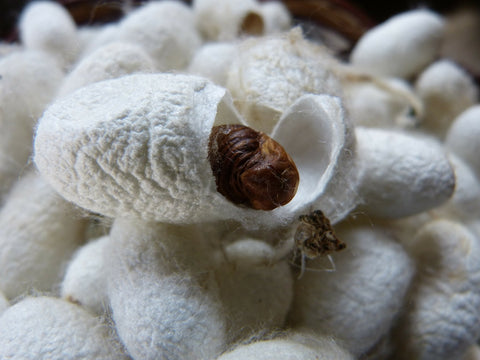Our planet is abundant with natural, sustainable fibres. Natural fibres are defined as those that are derived from plants, animals, or minerals. The fashion industry focusses more on the production of plant (cellulose) and animal (protein) fibres, as they are less irritating to human skin and are generally more sustainable than synthetic materials.
The most common natural fibres found in the fashion industry are:
-
Wool
-
Silk (Farmed or Wild)
-
Cotton (Commercial or Organic)
-
Flax (Linen)
Other examples include Jute, Sisal, Hemp and Bamboo.

Silk
Silk protein fibres may be sourced from farmed silkworms or ‘Wild’ silkworm cocoons. Silk farms destroy silkworm larvae before they emerge from their cocoon. As the Silk is harvested before the cocoon is chewed through, more viable fibres can be collected. Wild Silk is gathered from cocoons after the larvae has exited them; less fibres are harvested overall, but their collection does not disrupt the natural life cycle of the insect.

Cotton
Cotton is the most popular fibre in the fashion industry. A cellulose fibre produced from the cotton plant, Cotton fibre dominates the textile farming world, taking up 95% of cultivated space. Most of the negative environmental effects of Cotton production occur during the processing stage; carbons emissions being of primary concern.
Organic Cotton farming is far more sustainable than the commercial alternative, and has recently become more widespread. As Organic and sustainable farming practices become more prevalent in the agricultural sphere, Cotton will continue to shift towards renewable status.

Flax / Linen
Flax is a cellulose fibre harvested from the stem of the Flax plant. Flax fibres can be spun to create Flax Linen, a popular fabric for clothing and bedding. Flax is traditionally extracted by hand, due to the fragile nature of the plant. The production process is a comparatively long one, with an average time of 100 days to transform raw fibres to produced fabric.

Wool
Wool is a protein fibre most commonly sourced from sheep fleece. Standard wool can be complimented or replaced altogether with fibres from other animals, including cashmere (goats), angora (rabbits), and camelid wool (alpacas, llamas).
Quality Wool fabrics are farmed for their soft texture, temperature regulation, low combustion risk, breathability and versatile nature. Due to its renewable nature, Quality Wool is considered a more sustainable option than most synthetic fabrics. In order to remain sustainable, Wool farmers should consider the effects of agriculture on their local natural environment; protecting waterways and native species, avoiding overgrazing, and limiting live animal transport.



